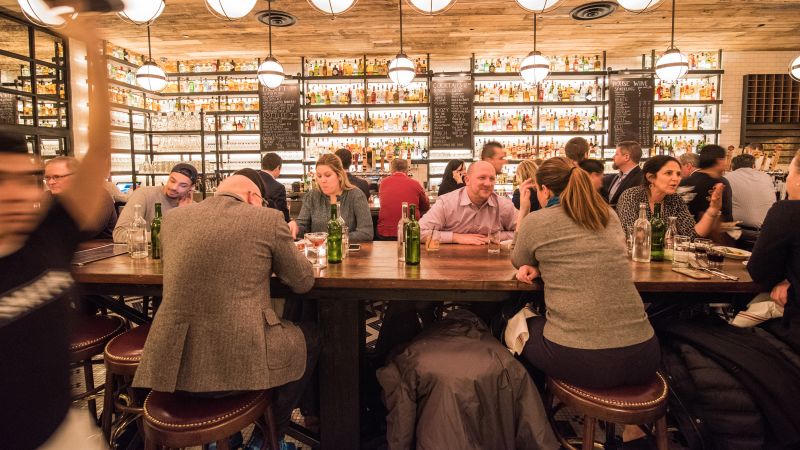In the 1984 rom-com “The Lonely Guy,” a crowded restaurant goes silent when Steve Martin tells the host he wants a table for dinner alone. A spotlight shines on him as he walks awkwardly to his seat.
Too embarrassed to acknowledge he’s having dinner out by himself, Martin pretends to be a restaurant critic and pulls out a notebook when his order arrives.
But the stigma of single dining has faded as more people live alone than ever before. Today, more people are making reservations for one.
On restaurant booking platform OpenTable, online reservations for parties of one at sit-down restaurants increased 8% for the 12 months ending on May 31, compared with the same time the year prior. An online survey of 2,000 consumers in June commissioned by OpenTable found that 60% of respondents had dined alone in the past year, including 68% of Gen Z and Millennial respondents.
Some people prefer dining solo because it’s convenient, with no cooking or cleaning up at home. Others are actively seeking out solo meals as a way to try new restaurants. Millennials and Gen Z are driving the growth of solo dining, according to surveys, restaurant owners and industry observers. Social media has made it easier for people to find restaurants well-suited for a meal alone, and demographic trends have bolstered the trend.
The growth of fast-casual restaurants like Chipotle and Sweetgreen, which cater to solo workday lunches and convenient dinners, has also made it easier for some people to feel comfortable taking the next step and sitting down at a table or bar for lunch or dinner, experts say.
Dining trends are a reflection of larger swings in what’s happening around us, said Stephen Zagor, a restaurant consultant who teaches at Columbia Business School.
“Here, solo dining is the mirroring of bigger social behaviors.”
A record 30% of Americans live alone, and people are marrying later than ever before and less often than ever. Only 37% of Americans ages 25-49 were married with kids, down from 67% in 1970.
Surveys show that consumers’ attitudes toward dining alone has also changed. In a 2022 survey of 1,200 consumers, market research firm Mintel found that 60% of respondents felt comfortable eating alone at a casual dining restaurant.
Some solo diners see a meal alone as a way to unplug and treat themselves, said Robin Chiang, the chief growth officer of OpenTable. OpenTable’s survey showed “me time” as the top reason people dined solo. “Much-needed alone time” was also the top reason cited for dining out solo in 2023 survey commissioned by restaurant booking app Resy.
“I kind of prefer it because you get to experience it on your own and make connections,” said Leandra Moultrie, 34, a marketing professional and self-described foodie who frequently dines solo in Orlando, Florida, for brunch, lunch, dinner and chef’s tastings.
The rise of food bloggers on Instagram has made it easier for her to discover intriguing places to have a meal alone, Moultrie said. She has used her solo outings to try new cuisines and interact with bartenders, servers and other guests. She usually seeks out a table, but she will sit at the bar at lively restaurants.
Moultrie admits she gets questions from restaurant staff and other diners when she eats out alone, like if she is waiting on a date.
Restaurants are noticing the solo dining trend too and adjusting their strategies, such as adding more chef’s tables and countertop seating arrangements.
“From the restaurant side it’s an opportunity to fill seats. Restaurants sell seats not tables,” said Zagor.
Yasmin Wages, the co-owner of Thai and Vietnamese restaurant Malai Kitchen, which has four locations in the Dallas-Fort Worth area, told CNN that Malai Kitchen is seeing an increase in single reservations for lunch and late-afternoon meals.
“Previously, solo diners would prefer to sit at the bar,” she said. “Increasingly so, they’re preferring a more private table or booth.”
Wages’ newest restaurant, which opened three years ago, was designed with smaller, two-person booths. They’re proving perfect for single diners. Each dish on the menu is designed as an individually sized portion, which is also a draw for people eating alone.
“Solo diners have a little cubby. They really like the intimacy, the privacy,” Wages said.
Solo dining used to be looked down upon, she said. Now it “looks peaceful to me. You can disconnect from the world for 40 minutes and enjoy your food.”
Adam Burke, the vice president of operations at Corner Table Restaurants, which owns The Smith and Parla in New York City, Chicago and Washington, DC, told CNN that solo dining is “something we love to key in on.”
Solo diners are often more interested in asking questions and engaging with staff than others, he said. Servers and bartenders are trained to give additional time to single diners, explaining new menu items and offering suggestions.
“There’s a degree of intention” among people who come in to have a solo meal, Burke said. “You get a very engaged connection with this guest. It presents an opportunity to give them a special experience, and they’re probably curious about what we’re doing.”
Read the full article here
